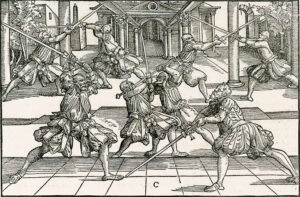HEMA stands for Historical European Martial Arts.
I listen to a podcast called the HEMAcast, and the host Patrick McCaffrey loves to ask all of his guests on the show one question – is any one of those letters in HEMA more important than the others?
Almost universally, their answer in some way conveys that the union of those four concepts is what really makes the (albeit broad) genre or art what it is. There have been a lot of conversations (and debates) recently about the validity of the “H” in HEMA, though, as more people have taken up the art and instruction has spread wider.
For what it’s worth, I’m not an expert on the subject. I’m an archaeology student, instructor and club founder (shameless plug: Black Flag HEMA in Tampa, FL – www.TampaBayHEMA.com), but like many instructors, I’m simply one page ahead in the manuscript and have a background in swordsmanship and teaching methodology. So please, take my observation and opinion as precisely that. Veterans will already know much of what I’m talking about in this article, but these were questions I came across early in my journey that I thought it would be important to remind newer folks we are still asking ourselves.
An Incomplete Picture
One of the largest problems with that H, with history in general, is that it isn’t, well, here. It’s old, done with, kaput, in the past. Historians, anthropologists, and anyone who has ever even slightly dabbled in trying to reconstruct something absent from modern culture understand that we are incapable of perceiving the whole picture in the context of those who created the record. Not that we aren’t trying, or shouldn’t, but we are physically incapable, because we lack said context.
For those of you who didn’t have that particular experience in your bag, or went a different path through academia – think about when you’re chasing your way back through a chain of emails, trying to find that one important thing the person said. Now imagine it’s a group chat. With hundreds of people. On a phone that nobody makes anymore. But you have screenshots of the messages. They’re probably in order. But also they belonged to somebody else who kept them private for hundreds of years and you don’t know if they kept them all, or rearranged them, doodled on them. Also, they’re in a language you don’t speak. Actually, they’re in a language nobody speaks because the dialect split and phased out.
Yeah, it’s sort of like that.
So is the history a lost cause? Not at all.

Plate from Meyer’s Longsword section. I have serious pants envy.
My club, for example, studies predominantly from Meyer’s 1570 treatise Gründtliche Beschreibung der Kunst des Fechtens. It’s a great source material for later period German longsword, dussack, and “rappier” (let’s not get started on sword names), it explains in relatively thorough detail many of the physical and mechanical actions presented in the book, as well as the tactics on when and why to use them.
Sort of.
There are some key details that are missing that require informed inference and thorough analysis. For example: the book loosely describes why it was written, and for whom, but never outright says “this is for soldiers at war” or “this is for fighting this specific sort of fight of which you’re surely familiar, contemporary reader, since they happen to 30% of men before the age of 19!”. Wouldn’t that kind of direct language or statistics be wonderful? However, it is exceedingly absent from many of the texts available.
So we have to work towards filling in the gaps – we do this for the examples above with historical context. Richard Marsden released probably my (current) favorite HEMA-related book, Historical European Martial Arts in its Context, which is primarily a collection of judicial records, personal letters, firsthand accounts, and more regarding the martial and social context that many of the arts or masters that are popular in HEMA today would have encountered in their time. This book is invaluable to the recreation of European martial arts without a living tradition because it contextualizes the otherwise purely mechanical or informative.
If there is a time I somewhat despise western esotericism, it is in trying to get the whole picture from a purely written example in the European Renaissance.
Frog DNA
This expression has become almost a trope in HEMA circles – the dreaded “frog DNA”. You’ll recognize it as a reference to Jurassic Park’s reference to redeveloping dinosaur genetics: where the dinosaur DNA was incomplete, they inserted frog DNA to make up the gaps (and bird and reptile DNA, in the book – but lets not dive into hypothetical sci-fi genetic theory from the late 80’s and early 90’s).

I trusted you, Mr. DNA. You made so much sense to younger me. Stupid scientific breakthroughs in genetics.
Aside from cultural context mentioned above, there do exist some mechanical or purely informative gaps in the texts as well.
In HEMA, “frog DNA” has become a reference to utilizing existing or in some way “proven” martial theory (the frog DNA) to make up for the gaps presented where written text and still images are lacking for a historical style/method/text/author (the dinosaur). One of the most common ways this comes up is due to the fact that capturing a human body in motion prior to the advent of film was literally impossible.
So frog DNA seems reasonable – we have modern martial theory, martial arts with sustained lineages, and we have a certain (contrived) environment to test a martial theory in (to an extent – I keep adding a lot of these qualifiers… mostly because none of us will likely ever, EVER, be in a “real” sword fight). Well lacking experiential data and with the gaps mentioned above, why is frog DNA risky or dangerous?
Well, that depends on how important that “H” is.
Once the “frog DNA” is introduced to fill in the perceived gaps in a historical text or style, it ceases to be entirely historical. By thoroughly researching the material and the context surrounding it, what led to and inspired its creations, similar works by other masters, and more, we can get as close to a historically accurate technique as possible. The sheer fact remains, however, that it is impossible to know with 100% certainty if we are sword-fighting the way that people fought in the period.
It’s also risky because it’s easy. It’s always easier to lean on the familiar than it is to learn the foreign, and for folks with a background in martial arts that stems from someplace OTHER than HEMA, it’s very easy to start working things in. I learned the easiest explanation for power principles I’ve ever heard from a black belt in American Kenpo, for example – well, every time I borrow that explanation, I have to make sure to qualify it to my students that it does NOT come directly from the source.
Hell, that concern even extends once you start working from multiple sources. If you’ve ever worked with somebody who does a specific sword style in HEMA, and then starts crosstraining a different weapon or style, they constantly equate the new knowledge to the knowledge they already possess. This isn’t a bad thing, it’s how our brains work, we simplify knowledge acquisition by categorizing and forming relationships between abstracts in our squishy skull core – but it does make it hard to isolate and differentiate something working in sparring, something martially valid and historically inspired, something historically and martially valid in a specific time and place, etc.
Mutual Exclusivity
This is my favorite part of HEMA – the part where anyone can do it the way they want. I have a variety of folks who come to my club – some competitive in the tournament scene, some hobbyists, some actors who want some historical or martial basis for their choreography, and others.
Yes, instructors have a higher degree of responsibility in this regard – but their responsibility isn’t to be historically accurate, their responsibility is to be HONEST. If an instructor teaches “German longsword” but it’s mostly stuff they’ve invented with German names to sound fancy, that’s a disservice, even if their made up nonsense is totally practical and very martially valid. They should rename their school “John’s Badass Modern Swordsmanship for Preppers and Post-Apocalypse Nuts”.

Barter town is a rough place – if you double even once, you can only wear motocross pads and furs for the rest of your life. So. Basically just your HEMA kit.
I’d go at least once.
The real debate then, is how much can an instructor dismiss the “H” and still call what they do HEMA? If it has a sword, and we’re sword fighting (which people clearly did back then), is it HEMA? Tough call.
Frog DNA (and other artifacts of interpretation that work their way into combat) is only dangerous when ignored, or when the claim is that a particular interpretation of a text is purist or lacking in influence from outside experience. That’s the point then, really – is that we need to talk about these things, and be forward and honest about when something is interpretation, when it’s hard evidenced fact, and when we’re just winging it. Historical accuracy is not mutually exclusive to fun, and vice versa. If the goal is to reconstruct as accurately and with as much historical validity as possible, then precautions and thorough research needs to be gone. If the goal is to introduce a handful of historical influences to stage fight, the priorities change.
This is the other issue that I run into frequently – historical accuracy does not necessarily equal fantastic swordsmanship or competitive success, and likewise, being able to tag your partner in sparring as often as possible doesn’t mean you’re nailing the techniques in the text, it just means whatever you’re doing happened to work. It often can, and does, correlate – however free play or sparring isn’t exactly a controlled environment – there are so many variables aside from the interpretation being executed in comparison to the historical evidence. The sample size is also exceedingly small to verify any sort of claim of efficiency or efficacy that could be observed in a few bouts.
So what can we take away? Above all things, context matters. The context of how and why the texts were written, how and why you intend to study HEMA, how and why you love swords and have fun. We as a community need to be both accepting of the goals of our peers, and rigorously analyzing claims of authenticity or validity in interpretation, no matter their source. The famous American anthropologist Franz Boas had around 15 published works between 1906 and 1966 – even his 1966 publication, after decades of leading the field, has an “Editor” credit and was peer-reviewed.
Thankfully, of all the things there might be a shortage of in the HEMA community, a willingness to debate seems in steady supply. As both a fencer and an academic researcher, I strongly hope these well-minded debates continue into the future to challenge us all to do our best work and to be honest about our intentions.
